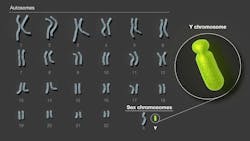An international research team has generated a complete sequence of a human Y chromosome, the final human chromosome to be fully sequenced. The new sequence, which fills in gaps across more than 50% of the Y chromosome’s length, uncovers important genomic features with implications for fertility, such as factors in sperm production. The study, led by the Telomere-to-Telomere (T2T) Consortium, a team of researchers funded by the National Human Genome Research Institute (NHGRI), part of the National Institutes of Health, was published in Nature.
To tackle the most repetitive pieces of the human genome, the T2T Consortium applied new DNA sequencing technologies and sequence assembly methods, as well as knowledge gained from generating the first gapless sequences for the other 23 human chromosomes.
The complete Y chromosome sequence also reveals important features of medically relevant regions. One such section of the Y chromosome is called the azoospermia factor region, a stretch of DNA containing several genes known to be involved in sperm production. With the newly completed sequence, the researchers studied the structure of a set of inverted repeats or “palindromes” in the azoospermia factor region.
Deletions in the azoospermia factor region are known to disrupt sperm production, and thus these palindromes could influence fertility. With a complete Y chromosome sequence, researchers can now more precisely analyze these deletions and their effects on sperm production.
Other regions with potential medical relevance contain genes that repeat. Most genes in the human genome have two copies, one inherited from each parent. However, some genes have many copies that repeat along a stretch of DNA, sometimes referred to as a “gene array.”
The researchers focused on TSPY, another gene thought to be involved in sperm production. Copies of TSPY are organized in the second largest gene array in the human genome. Like other repetitive regions, repeating genes are challenging to analyze, so while TSPY was known to exist as many repeating copies, the specific DNA sequence and organization of this array was previously unknown. As the researchers analyzed this region, they found that different individuals contained between 10 and 40 copies of TSPY.
In addition to the complete Y chromosome sequence, the NHGRI-funded Human Genome Structural Variation Consortium reports the sequence of 43 diverse human Y chromosomes, also published in the same issue of Nature.

